Mars MOLA Viewer provides a simple, yet comprehensive look at the
topographic
data returned by the MOLA experiment on the Mars Global Surveyor.
When you start the program for the first time, you will see the an
introductory
screen and then the Configuration Window.
Configuration Window
On the configuration screen, you can select a directory to store the
topographic data files, and a URL from which to download them.
The defaults should work well for most people.
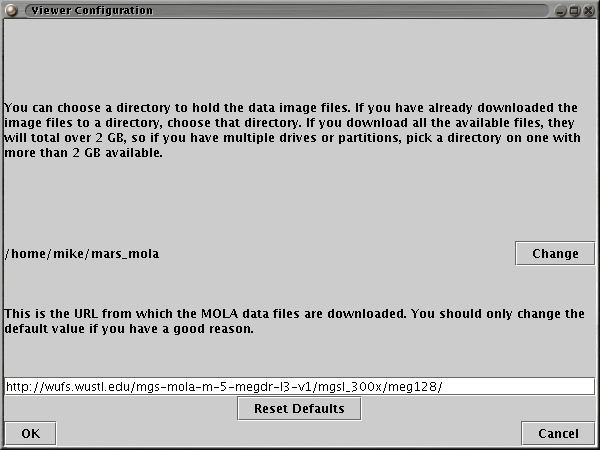
Data File Directory
By default the program will create a mars_mola directory
within your
home directory. The data files total about 2 GB; if you don't
have
that much space at the default location use the Change button
and choose a directory for the topographic data files on a drive that
does
have that much space. If you've downloaded the data files with a
different
program, choose the directory to which you downloaded them.
Download URL
This is the URL from which Mars MOLA Viewer will download the
topographic
data files. The default value is the official site at Washington
University
in St. Louis, Missouri, USA. If you know of a mirror closer to
you,
you can enter that URL here.
Main Map Window
The main Mars MOLA Viewer window shows a false-color topographic map of
Mars, between +/- 70 degrees latitude, in a Mercator projection.
This
map is divided into 16 sections, which represent the 16 topographic
data
files that Mars MOLA Viewer can use (actually, Mars MOLA Viewer can
show
to +/- 88 degrees latitude, but that doesn't show well on a Mercator
projection, so the polar regions aren't shown.) If you have the file
for a section downloaded, that section is shown in full color. If
the file is not downloaded, the section is shown grayed out. If
the file exists but is incomplete, the section shows with a pink
overlay. If you are in the process of downloading a file, the
section is shown with a green overlay and a progress bar. The
blue portion of the progress bar indicates how much of the file had
downloaded.
In this example, the sections around Olympus Mons and Valles Marineris
are
completely downloaded (and may be rendered); one section is actively
downloading,
and one section is incomplete but not actively downloading.
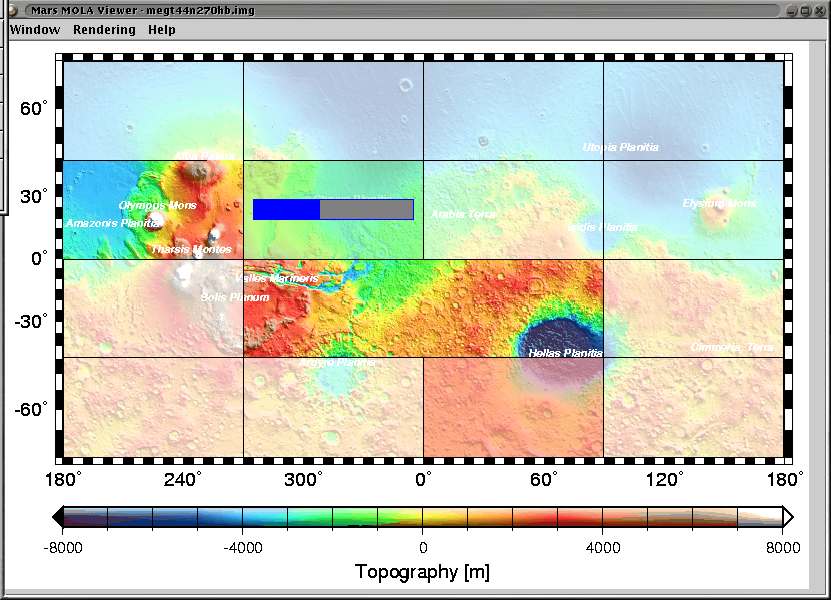
If you click on a section of the map that has not yet downloaded
completely (or right click on any section of the map) you will see a
pop-up menu listing what you can do with that section file.
Options are: Start a download, Resume an incomplete download,
Stop a download in progress, Restart a download (which you might want
to do if you think the file for a section is wrong or
corrupt for some reason).
Once any section of the map has downloaded completely (each section is
128 MB, so if you don't have broadband, downloading a section may be an
overnight operation), you can click on it to open the rendering window.
The map window will also show the day/night regions of Mars and plot
the book marks you've saved, if you enable those features.
Rendering Window
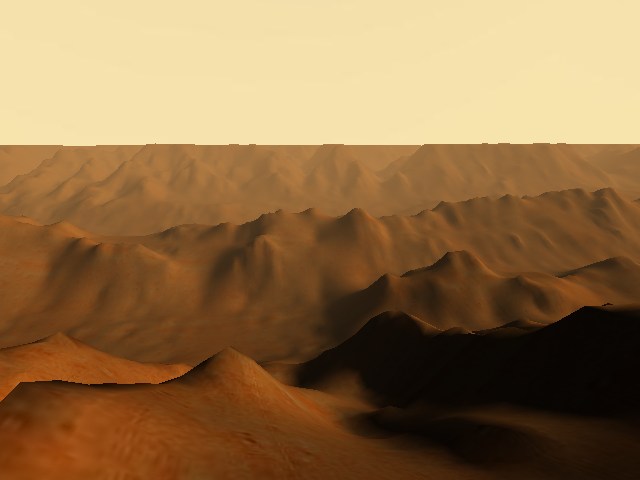
The rendering window is where all the fun happens. If you click
on a section of the map that you have downloaded, you will
open a rendering window giving a view of the Martian surface from a
camera
at that position. This might take a few seconds or minutes,
depending on the speed and memory size of your computer. If
your computer does
not support the 3D graphics techniques used, Mars MOLA Viewer will
probably abort now. If you click on the rendering window it
will get the focus. When the rendering window has the focus,
moving the mouse will change the direction you are facing on Mars.
Pressing the arrow keys will move your camera forward, backward,
left or right. Press the space bar to toggle a display of the
current frame rate (how many times a second the view is updating).
Press F to toggle a display of your current position
on Mars. Press F9 to take a screen shot. Press Alt-Enter to
toggle full-screen mode for the rendering
window. Press Escape to free the mouse for its normal behavior.
When the rendering window is running, a green triangle will show on the
topographic map showing your current position and the direction you are
facing.
You can click on any downloaded section of the map to quickly
change
your camera position to that point. If you move the camera to a
part
of Mars for which you haven't downloaded data, you'll just see
perfectly
flat terrain.
Mars Clock
Mars MOLA Viewer includes a
fully functional Mars clock. The map display will show the day
and night regions of Mars for the current date and time, or any date
and time you select, and the render window will show the correct sun
position and lighting angle for that time at your location (it will be
very dark on the night side of Mars!) The sun position is updated
periodically in real time: you can watch the sun rise or set from the
surface of Mars! Use the Show
day/night... option in the Date/Time
menu to enable this feature. The title bar will always show the
date and time you are displaying.
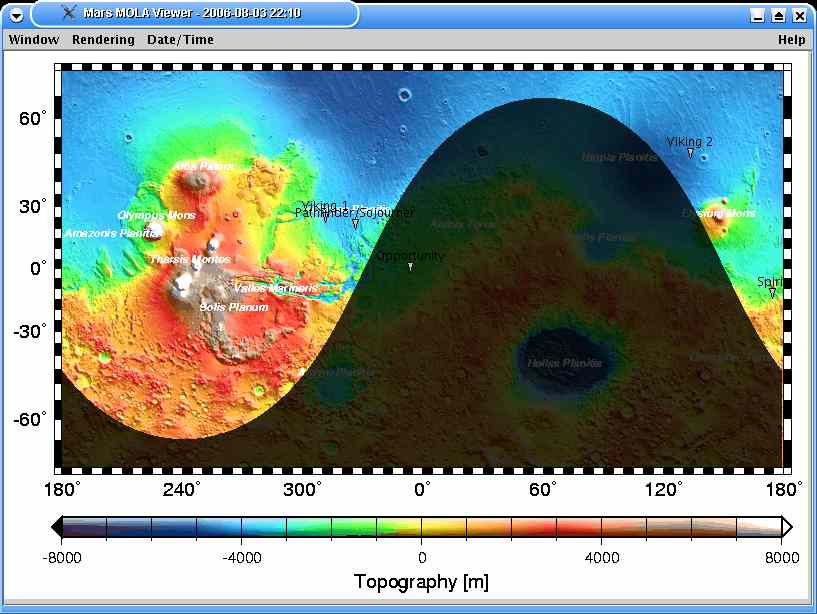
The Mars clock defaults to the current time but you can set it to any
date or time you want--perhaps to adjust the lighting conditions of a
scene you're looking at, or to see how a Martian feature looks in the
sunlight of different seasons. Use the Set date/time... menu option to open
the dialog that lets you set the date and time.
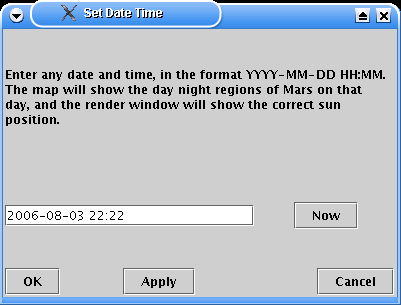
Change the date and time in the text box. The Now button is a shortcut to change
the text to the current date and time. The Apply button changes the set date
and time to the value you've entered in the field-- you'll see the
change immediately in the map window and the render window, if it's
open. The OK button
changes the date and time and also closes the dialog.
Bookmarks
Mars MOLA Viewer allows you to
save bookmarks that record what you're looking at in the render window:
your position, orientation, and the set date and time. You'll be
able to return to that point in the future, and resume your exploration
of Mars in the same area. The bookmarks can also be plotted on
the Mars map. The software ships with a small set of pre-created
bookmarks recording the landing position and dates of each successful
United States Mars lander (to date!)
Use the Edit bookmarks... menu
command under the Window menu
to create or update your bookmarks.
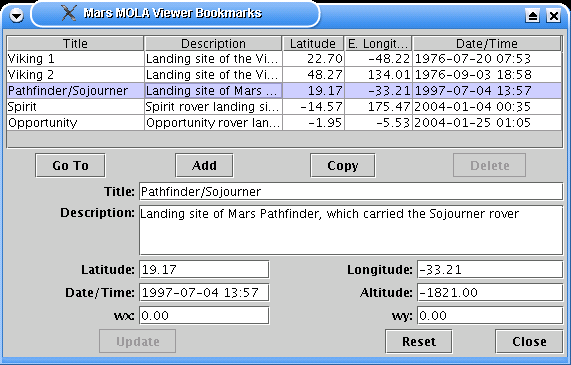
The table shows all the existing bookmarks. Select a bookmark by
clicking on it. All the information about the bookmark will be
displayed in the fields beneath the table.
The Go To button will open
the rendering window and position it at the selected bookmark; if the
bookmark is associated with a date and time it will also set that.
You can also create a copy of, or delete a selected bookmark. The
Add button will create a new
bookmark from your current position in the rendering window.
Bookmarks have a title, description, latitude, longitude and an
optional date and time. The title is displayed with the bookmark
when it is plotted in the map window. You can put any additional
text in the description. When you first create a bookmark, the
title and description are blank.
The wx and wy columns measure the orientation of the render window
camera. It's probably not useful to try and change these
directly, but you have the option.
When you've changed the information for a bookmark the way you want,
press the Update button to
update the table and save the changes permanently.
The Reset button removes all
the bookmarks except for the original set!
Menu Commands
Window Menu
- Show Download Status... opens a window that shows the status of
any current
file downloads (blue bars in the map window) in text form.
- Reconfigure... opens the configuration window again. The
rendering
window (if open) will be closed.
- Show bookmarks... This toggles the plotting of the bookmarks on
the main map window.
- Edit bookmarks... Displays the Edit Bookmarks dialog described
above.
- Quit -- exits Mars MOLA Viewer
Rendering Menu
- Fog (off/on) -- Turns on and off fog in the rendering window.
- Vertical relief... Brings up a window that lets you control how
much
the vertical relief is exaggerated. By default, the vertical
scale
is exaggerated by a factor of two to make features more visually
dramatic.
You can turn this off or exaggerate further.
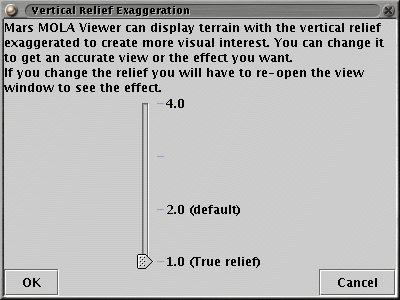
Date/Time Menu
- Show Day/Night This toggles the display of the day/night regions
of Mars in the main map window, and perhaps more importantly, changes
the lighting and sun position in the render window so that it is always
the same regardless of time or position (this is known as Fixed Light
mode, and was the only one available in previous releases of Mars MOLA Viewer).
- Set Date/Time... This opens the dialog used to set the date and
time.
- Set date/time to present This resets the date and time in
the program to be the current date and time.
Help Menu
- About... About this program
- Help... Displays this web page
- Release Notes... Displays the most recent release notes
Troubleshooting
Mars MOLA Viewer won't start
If Mars MOLA Viewer won't start at all, there is a probably a problem
with
the installation of Java Web Start. Please refer to Sun's
documentation
of Java Web Start for more information.
One problem that prevents Mars MOLA Viewer from starting is bad proxy
configuration
information in Java Web Start. If you are accessing the Web
through
a proxy server and Mars MOLA Viewer fails to start and you get an error
message
from Java Web Start, this might be the problem. Java Web Start is
supposed
to obtain the proxy information from your browser upon installation;
this
might not work. Or the proxy information may need to be changed.
Start
Java Web Start, select File/Preferences, go to the General
tab, and enter the correct proxy information.
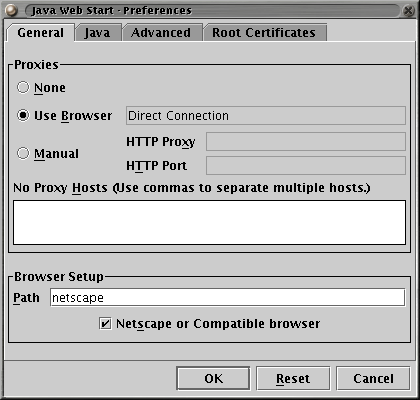
Welcome Screen Unresponsive
Because of an oddity in Java Web Start, when you start Mars MOLA Viewer
for
the first time, you might not be able to dismiss the welcome screen.
This
is because Java Web Start has put up its own window, asking if you want
to
add Mars MOLA Viewer to the desktop, and this window is taking all the
input,
even though it is hidden below the welcome window. You just have
to
bring the hidden window to the top so you can click on it and make it
go
away, and things will work normally.
Rendering Becomes Slow
If you open and close the Rendering Window more than once, rendering
may
become very slow. The only way to cure this is to exit Mars MOLA
Viewer
and then restart it.







